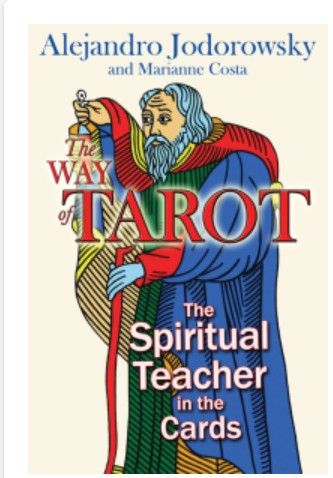Cybee's Online Tarot
Alejandro Jodorowsky
Alejandro Jodorowsky
The Way of Tarot
Alejandro Jodorowsky Prullansky (Spanish; born 17 February 1929)
The Alejandro Jodorowsky Prullansky (Spanish; born 17 February 1929), is a Chilean-French filmmaker and artist. Since 1948, Jodorowsky has worked as a novelist, screenwriter, a poet, a playwright, an essayist, a film and theater director and producer, an actor, a film editor, a comics writer, a musician and composer, a philosopher, a puppeteer, a mime, a psychologist and psychoanalyst, a draughtsman, a painter, a sculptor, and a spiritual guru. Best known for his avant-garde films, he has been "venerated by cult cinema enthusiasts" for his work which "is filled with violently surreal images and a hybrid blend of mysticism and religious provocation".
Reconstruction of The Tarot de Marseille
Jodorowsky spent almost a decade reconstructing the original form of the Tarot de Marseille. From this work he moved into more therapeutic work in three areas: psychomagic, psychogenealogy and initiatic massage. Psychomagic aims to heal psychological wounds suffered in life. This therapy is based on the belief that the performance of certain acts can directly act upon the unconscious mind, releasing it from a series of traumas, some of which practitioners of the therapy believe are passed down from generation to generation. Psychogenealogy includes the studying of the patient's personality and family tree in order to best address their specific sources. It is similar, in its phenomenological approach to genealogy, to the Constellations pioneered by Bert Hellinger.
By David Colman (NY Times 11/12/2011)
According to the art-film director Alejandro Jodorowsky, though, all deviations from the Tarot de Marseille are nothing but inglorious bastards.
“I’m a purist,” Mr. Jodorowsky said this month, standing at a display of tarot decks in a Greenwich Village bookstore, dismissing them one and all. He was in New York to be honored by the Museum of Modern Art, which was screening a retrospective of his films, including “El Topo” (1970) and “The Holy Mountain” (1973). But he was equally thrilled to talk about his abiding passion and hobby, the world of tarotica.
Mr. Jodorowsky, 82, certainly devotes as much time to it as he does to film these days. In Paris, where he has lived for the last 20 years, he lectures on the tarot and does readings for strangers once a week. And he vividly remembers how, at 20, he first saw an old (and, he said, naked) woman in his native Chile give a tarot reading, and was instantly intrigued. He soon moved to Paris, where he joined the mime company of Marcel Marceau and began traveling with him. It was in Tokyo, Mr. Jodorowsky said, that he first bought a tarot deck. This became a habit. Every place they went, he would figure out where and how to buy a new deck; before long, he had a vast collection.
A decade or so later, in the 1960s, when he was visiting an early hero, the Surrealist writer André Breton, he took along an obscure tarot deck as a gift, having heard that he was a fellow fan. But Breton had a trump card of his own.
“He told me that the only good tarot was the Tarot de Marseille,” Mr. Jodorowsky said.
And so, he started all over. He got rid of his collection and began obsessively studying the Tarot de Marseille, a historic tarot family with roots dating from the 16th century. Over time, he became something of a black belt, to mix dark-art metaphors. But he was always frustrated, he said, at not being able to find the perfect Tarot de Marseille deck.
Then, in the mid-1990s, he contacted the last descendant of the Camoin family, who had printed the Tarot de Marseille since the 19th century. Together, they worked for the greater part of a decade to piece together the ideal 78-card deck, filled with a wealth of arcane detail and with 11-color printing.
He never goes anywhere without it in his chest pocket. At least not without the so-called major arcana: the 22 cards most often identified with tarot, like the Lovers or Death. (The other 56 are, in essence, a deck of playing cards, with four face cards instead of three.) “The whole deck is a little much to travel with,” Mr. Jodorowsky said.
To him, the tarot is such a constant companion that it has become all-purpose: a point of reference, of reflection, of divination. He has put it into his films, he uses it to communicate in a nonliteral way, and it is a simple pastime to boot.
“The tarot is sacred,” he said, adding, “It’s all a game.”
In short, Mr. Jodorowsky’s philosophy of the tarot (about which he has written a book,
“The Way of Tarot”) is flexible and even slippery. But it does appear that tarot can be everything and anything you want it to be. Maybe the tarot doesn’t need to learn from the iPhone. The iPhone needs to learn from the tarot.
If you want to read his book, click on the link in
RED above and download it in (.pdf format) or go to FREE STUFF from the Menu at the top of the page and then DOWNLOADS to download from there.
